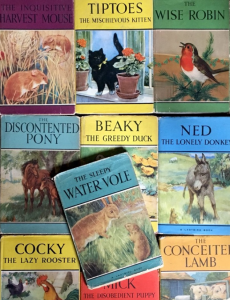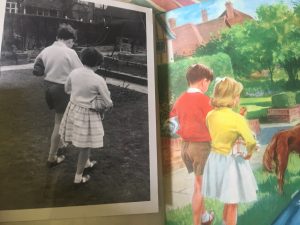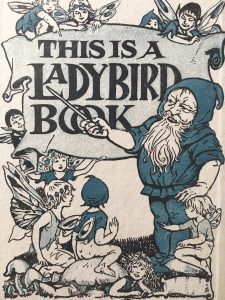PLEASE NOTE - this blog has now moved to:
My top-10 of Ladybird book trivia
Or 'ten things you have probably never wanted to know about Ladybird books'
10
The price of a Ladybird book (2 shillings and 6) stayed the same for 31 years -from 1940 until 1971 (decimilisation).
Over those thirty-one years, the increased book sales and lower production costs allowed the company to fulfill its commitment to produce good quality and affordable books. Even at the time of decimilisation, the director's strove to maintain the relative price of the books - but in the face of post-decimilisation inflation, they were forced to concede defeat. (The one positive side of this for collectors is that the price stamped on the back of many Ladybird books after 1970 helps identify the age of the book where other clues are lacking).
9
The artist Frank Humphris was an honorary member of a native American tribe and was also temporary deputy sheriff of Bexar County, Texas.

It was his passion for all things to do with 'The Wild West', led Douglas Keen to create a series of books for him: series 707. He illustrated them all and also wrote the books 'Cowboys', 'Indians of the Western Plains' and ''Battle of the Little Big Horn'. Humphris' fascination for the subject earned him the nickname 'fast draw'. He was another of the artists who came to Ladybird after working on the Eagle comic, where his work included another western-themed comic strip 'Riders of the Range', which he drew until 1962. Perhaps because they both worked for Eagle before Ladybird, Frank Humphris is sometimes confused with Frank Hampson.

8
Writer Noel Barr was a woman.

Noel Barr wrote the ever popular Animal Tales such as 'Mick the Disobedient Puppy', 'The Wise Robin', 'Beaky the Greedy Duck', 'Ned the Lonely Donkey' and 'Tiptoes the Mischievous Kitten'. Perhaps not surprisingly, commentators all too often refer to Barr with the pronoun 'he'.
7
Producing a Ladybird book was often a family affair.

There are various examples of husband's illustrating books which had been written or conceived by their wives. Family members were also often drafted in to act as models for the illustrations. A case in point is the book 'The Story of Metals' which was written by the father, Lesley Aitchison, illustrated by son, Martin Aitchison, and modelled for by grandson Nick.
6
After the WW2, Ladybird came close to stopping children's book publication for good - intending that their post-war core business would again be commercial printing.
 Wills & Hepworth car brochure[/caption]
Wills & Hepworth car brochure[/caption]Douglas Keen, the visionary employee who steered Ladybird to phenomenal success, was advised to concentrate on Motor Trade publishing when he returned to the company after war service because the directors saw no future in children's publishing.
Fortunately, he didn't heed the advice, but instead set to work to convince the board that this was the area of the company to develop. His efforts finally bore fruit in the early 1950s. Today most people would be unaware that the company behind Ladybird ever printed anything else.
5
Ladybird Books' commissioning editor Douglas Keen considered himself to be a Marxist.

Although commercial considerations always had to come first, Keen's beliefs shine through nonetheless, for example in the emphasis placed on public services, especially free education, libraries and healthcare.
4
Five different artists illustrated, and reillustrated, the Peter and Jane key word reader series over a period of 14 years.

They each used different models so there are lots of different 'real Peter and Janes' walking around today.
3
 The Ladybird logo feels timeless - but the brand had no logo at all for the first 27 years of publishing.
The Ladybird logo feels timeless - but the brand had no logo at all for the first 27 years of publishing.

Even when the first logo was devised (1941) it depicted a rather indistinctive ladybird in flight.
2
Ladybird artist Martin Aitchison, who illustrated many of the Peter and Jane books, had worked with Barnes Wallis, producing illustrations to help Wallis 'sell' his idea of a bouncing bomb.

Aitchison's deafness barred him from active service but his war work was for Vickers Aircraft. Aitchison's father had been a friend of Wallis from university days.
1
Until the 21st century, not one Ladybird book was ever branded 'For boys' or 'For girls'.

This was an important tenet of the company over the Douglas Keen years. Nor were colours used to guide boys or girls more indirectly towards particular choices; in most cases the choice of book spine colour appears to have been a random one.
(For more of such fun-facts, see ladybirdflyawayhome.com)
